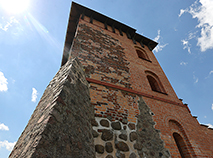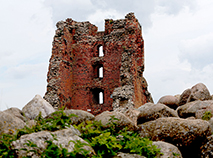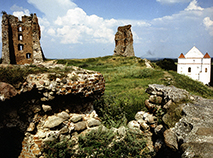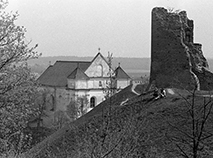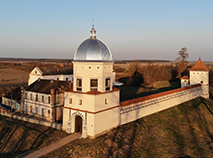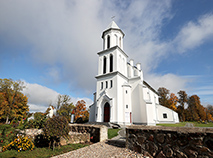Novogrudok Castle
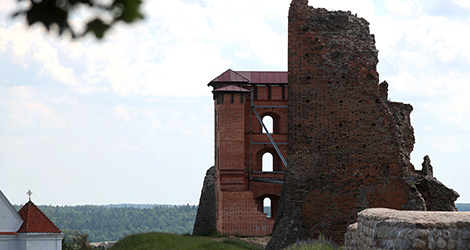
Many centuries ago, the seven-towered stone castle of Novogrudok was a mighty citadel of the Grand Duchy of Litva (Lithuania), one of the largest states in medieval Europe. Unfortunately, only two towers and the ruins of the walls have survived on Zamkovaya Gora (Castle Hill). But even today’s Novogrudok Castle reflects the glorious past of the Neman lands and is one of the most visited landmarks in Belarus.
Now restoration works are underway on the ruins of Novogrudok Castle. It is planned that the main tower - the legendary Shield Tower (central tower) will be restored to historical dimensions and will become a museum with a "cold exposition". This concept allows avoiding building underground utilities to the ancient Castle Hill and interfering with the historical cultural layer.
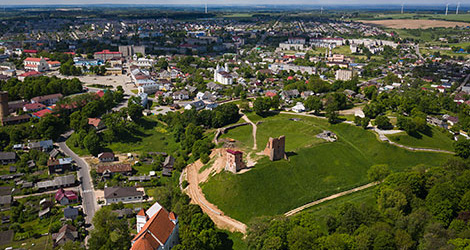
History of the castle in Novogrudok, the first capital of the Grand Duchy of Litva (Lithuania)
By the will of history, by the 13th century Novogrudok, standing in the valley of the Neman River, turned into a major political center of its time. It gained the greatest weight under Grand Duke Mindouh, the founder of the Grand Duchy of Litva (Lithuania). Novogrudok became the first capital of the new state of medieval Europe: the city hosted the Sejms, meetings of the Tribunal of the Grand Duchy of Litva (Lithuania), meetings with foreign rulers and ambassadors...
No later than 1323, Grand Duke Hiedymin ordered a new residence and moved the capital to Vilna. Novogrudok lost its political significance but it served as the most important outpost and one of the Grand Duke’s properties for a long time.
At the end of the 14th – early 15th centuries, Grand Duke Vitaut ordered Lipka Tatars to settle in Novogrudok and the vicinity and registered the city in the lifelong possession of his wife Ulyana in 1428. In 1415, the Council of Orthodox Bishops in Novogrudok elected Gregory Tsamblak Metropolitan of the Grand Duchy of Litva (Lithuania): the Synod actually declared the autocephaly of the Orthodox Church in the Grand Duchy of Litva (Lithuania). In 1422, it was in Novogrudok in the Transfiguration Church at the foot of the castle that King of Poland and the Grand Duke of Litva (Lithuania) Jahajla wedded Princess Sophia of Golshany. This marriage started the Jagiellonian dynasty... All this confirms the significant role of the city over the centuries.
In the 13th century, under Mindouh, the first stone tower-donjon – Shield Tower was built on the Castle Hill to replace the wooden stronghold. It defended the city from the enemy more than once, was destroyed and rebuilt, but still remained the only stone fortification for a long time. Large-scale construction of the castle began only at the end of the 14th century.
Three-tiered stone towers with arrow slits on each floor grew on a high hill. They were connected by 10-12-meter thick walls. The Well Tower was built on a place where springs flowed supplying the castle with water. The grand duke’s palace, a stone church, a building of the Tribunal - the highest appellate body of the Grand Duchy of Litva (Lithuania), military barracks, an arsenal building, and outbuildings were built inside the citadel. A large Watchtower was erected in the early 16th century. It was connected with the Shield Tower with thick walls thus forming a ring around the fortifications.
By the beginning of the 16th century, the seven-tower outpost in Novogrudok became the most formidable and impregnable castle in Eastern Europe. The Tatars and the Teutonic Knights tried to storm it more than once: three masters of the Teutonic Order are believed to be wounded during the siege of Novogrudok, and one of them never returned to Marienburg alive.

Novogrudok Castle in the 14th century. Belarusian artist Viktor Staschenyuk
History was merciless to the castle. Many of its towers and walls were destroyed during the hostilities of the second half of the 17th century. There was neither political will nor funds to restore it. The remaining fortifications were destroyed during the Great Northern War.
In 1802, Governor-General Leonty Leontyevich, count von Bennigsen, ordered to use stones from the walls... to pave the city streets and roads. Significant remains of the Shield Tower and the Church Tower have survived to this day (half of the Shield Tower collapsed in 1906, and most of the Church Tower fell down in 1914), as well as the ruins of walls and other towers, miraculously surviving through the centuries.
Novogrudok Castle today
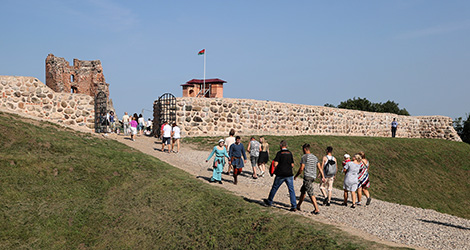
Located 323 meters above sea level, Zamkovaya Gora (Castle Hill) is the highest point of Novogrudok and one of the highest points in Belarus. It offers a panoramic view of the city, and the place itself is unique.
Since 2012, a six-stage architectural project “Reconstruction, conservation and adaptation of the historical and cultural legacy of Novogrudok Castle” has been running on the premises of the castle. Work was done to conserve the Church Tower that was on the brink of destruction, to strengthen the slopes of the Castle Hill, to create a drainage system from the castle bowl, to conserve the ruins of the Watchtower, Posadskaya Tower and Entrance Tower and the stone walls of the citadel and to partially restore the walls... It is noteworthy that before the start of the works, most of the walls and ruins of the castle fence lay in the ground, and the ruins of the Posadskaya Tower and the Watchtower were covered with security boxes.
The 6th stage of the project is underway now. It provides for the restoration of the main tower of the castle – the Shield Tower. It includes the restoration of fragments of the surviving walls and the recreation of the lost ones: their height will be as close as possible to the surviving part.
Authentic walls will be reinforced and repaired to remove cracks and chips and restore some lost parts. Handmade restoration bricks will be used to replicate the old ones in size, color, and texture.
The lost walls of the tower will be recreated using the ancient masonry method: according to experts, the technique will help display the difference between the ancient and restored walls.
According to plans, the restoration works will return the Shield Tower to its previous glory. The six-tier tower-museum with a diameter of 11.4m at its base sits atop Novogrudok's Castle Hill. The bottom tier is located at the depth of more than 5 meters, the upper one - at a height of 12.5 meters (according to known data, the tower as 25m high). The walls will be more than 1m wide: inside one of the recreated walls there will be an internal staircase which will lead to the top of the tower. A metal staircase will be installed for descending.
The Shield Tower will house a museum narrating the history of the ancient castle and the Novogrudok lands that gave rise to the Grand Duchy of Litva (Lithuania).
The lower tiers will display the ancient foundations and walls of the tower, and also the remains of the foundations of the Tribunal Palace. The upper tiers will display artifacts that can be exhibited in the cold museum. The collection features objects found by archaeologists during excavations on the Castle Hill in different periods of the 20th century. No archaeological research is carried out during the ongoing restoration, but scientists are closely monitoring the works. The cultural layer lies at a depth of over 4 meters, which allows working on the surface without disturbing it.
Multimedia devices will be installed to help visitors of the future Shield Tower museum to get more information about the exhibits.
An observation deck under the roof of the tower will be used as a conference hall and a space for temporary expositions during the warm season.
The Shield Tower restoration project also envisages the restoration of one of the oldest medieval toilet facilities in Belarus, a dansker.
In the autumn of 2024, with the completion of another stage of the restoration project, the Novogrudok Castle grounds became a protected site. It can be visited from 10:00 to 17:30 on all days except Monday. Entry is Br1. Children under 7 years old can visit free of charge.
How to get there and where to stay

Novogrudok is located about 150km from Minsk. The fastest and most scenic route from the Belarusian capital runs along the roads P1 and E30/M1 (to the south-west of the country). It is advisable to choose P64 at the turning with the Mir Castle sign and, once in the town of Mir, take P11 leading to Novogrudok.
Address: Maly Zamok Street, Novogrudok, Grodno Oblast, Belarus
Coordinates: 53.60155, 25.82737
You can spend some time in Novogrudok as well. There is a lot to see in the city.
Sights near Novogrudok Castle
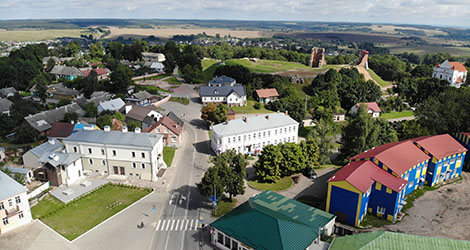
Novogrudok is not only the first capital of the Grand Duchy of Litva (Lithuania), but also the birthplace of the romantic-era poet Adam Mickiewicz, the center of important historical events. Apart from the ruins of the ancient castle, there are numerous sights associated with different epochs and distinguished individuals. The list of interesting places includes Mindouh Mount, Church of the Transfiguration of the Savior, Church of St. Michael the Archangel, the Church of Sts. Boris and Gleb, Cathedral of St. Nicholas, house-museum of Adam Mickiewicz and a mound in honor of him, museum of Jewish Resistance, hotel room-museum of actor and bard Vladimir Vysotsky…
The way from Minsk to Novogrudok goes through the town of Mir. The town is known for Mir Castle, a UNESCO World Heritage site, one of most beautiful castles in Europe.
Another sight, Lyubcha Castle, is located 25km from Novogrudok. It stands on the high bank of the Neman River. Over 400 years ago, the influential Kiszka family built the castle. Later, it became one of the residences of the Radziwills, the most powerful family in the Grand Duchy of Litva (Lithuania).
The village of Shchorsy, which is 25km from Novogrudok and 15km from Lyubcha, is home to the once luxurious estate of Count Joachim Litawor Chreptowicz, the last Grand Chancellor of Litva (Lithuania). He founded the famous library of the Chreptowicz, which existed from the second half of the 18th century to the early 20th century. This book collection was considered one of the most extensive in Eastern Europe. It contained over 20,000 books in different languages: works of ancient authors, French and Italian classics, unique historical documents, manuscripts, geographical maps. Famous scientists and writers came to work here. Adam Mickiewicz wrote his poem Grazyna in Shchorsy.
The agro-town of Vselyub, Novogrudok District (14km from the city), is known for St. Casimir Church. It is the oldest surviving Catholic church in Belarus. It was erected before 1433. The church is an example of a harmonious combination of Belarusian architectural traditions and Western European architecture.








 print version
print version make home page
make home page add to bookmarks
add to bookmarks

